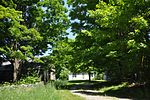Harvard Forest
1907 establishments in MassachusettsForestry museums in the United StatesForests of MassachusettsHarvard UniversityMuseums in Worcester County, Massachusetts ... and 4 more
Petersham, MassachusettsProtected areas established in 1907Protected areas of Worcester County, MassachusettsResearch forests

Harvard Forest is an ecological research area of 3,000 acres (12 km2) owned and managed by Harvard University and located in Petersham, Massachusetts. The property, in operation since 1907, includes one of North America's oldest managed forests, educational and research facilities, a museum, and recreation trails. Harvard Forest is open to the public.
Excerpt from the Wikipedia article Harvard Forest (License: CC BY-SA 3.0, Authors, Images).Harvard Forest
North Main Street,
Geographical coordinates (GPS) Address Nearby Places Show on map
Geographical coordinates (GPS)
| Latitude | Longitude |
|---|---|
| N 42.531325 ° | E -72.189788888889 ° |
Address
Harvard Forest Administration Building
North Main Street 324;326
01366
Massachusetts, United States
Open on Google Maps









